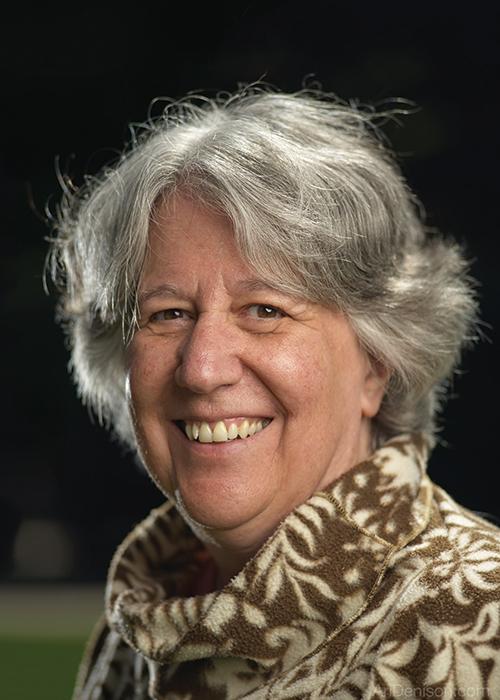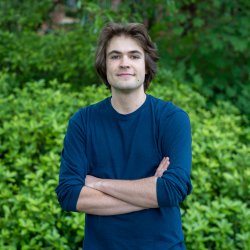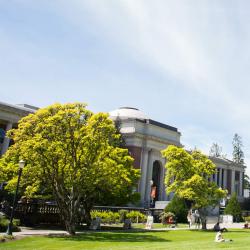
Corinne Manogue
Corinne Manogue
Biography
Corinne Manogue studied black holes from Denis Sciama and the interface between quantum theory and general relativity from Bryce DeWitt, obtaining her PhD in physics from the University of Texas at Austin in 1984. After postdoctoral positions at the Institute for Advanced Study in Princeton (1984-86), the University of Durham in England as an SERC Fellow (1986-87), and at both the Institute of Mathematical Sciences (Madras) and the Tata Institute for Fundamental Research Bombay as an Indo-American Fellow (1987), she joined the physics faculty at Oregon State University in 1988.
From its inception in 1996 until 2022, Prof. Manogue was the driving force behind the Paradigms in Physics project at OSU, a complete redesign of the physics major involving the creation of 19 new courses, as well as a shift from traditional lecture to active engagement. This project has been continuously supported by NSF since its inception. The project website articulates the details of many of the new courses, as well as the more than 500 group activities.
Recent Courses: PH422 Paradigm: Static Fields, PH426 Paradigm: Central Forces
Research
Research Interests in Theoretical Physics
Dimensional Reduction and Octonions
My long-term goal in this research is to describe the fundamental symmetries of physics by exploiting the symmetries inherent in exceptional mathematical structures involving the octonions, a non-commutative, non-associative extension of the complex numbers.
My results have included:
- a demonstration that the non-linear Virasoro constraints of bosonic string theory and the superstring equations in 10-dimensions are both simple restatements of the octonionic multiplication rule;
- an explicit alternative to exponentiation for the description of finite Lorentz transformations which evades the twin hazards of non-commutativity and non-associativity;
- a proposal to use the octonionic formalism to reduce ten spacetime dimensions to four, without the usual compactification required by superstring theory;
- the application of this symmetry breaking to the Dirac equation resulting in a particle spectrum with the correct number of generations and spin/helicity properties to describe precisely three generations of leptons.
Representative Publications in Theoretical Physics
- David B. Fairlie & Corinne A. Manogue, A Parameterization of the Covariant Superstring Physical Review D 36 (1987) 475-479.
- Corinne A. Manogue & Anthony Sudbery, General Solutions of Covariant Superstring Equations of Motion, Physical Review D 40 (1989) 4073-4077.
- Corinne A. Manogue & Jörg Schray, Finite Lorentz Transformations, Automorphisms, and Division Algebras, Journal of Mathematical Physics 34 (1993) 3746-3767.
- Paul Davies, Tevian Dray & Corinne A. Manogue, Detecting the Rotating Quantum Vacuum, Physical Review D 53 (1996) 4382-4387.
- Corinne A. Manogue & Tevian Dray, Dimensional Reduction, Modern Physics Letters A 14 (1999) 93-97 (invited paper).
- Tevian Dray and Corinne A. Manogue, The Geometry of the Octonions, World Scientific (2015).
- Robert A. Wilson, Tevian Dray, and Corinne A. Manogue, An octonionic construction of E8 and the Lie algebra magic square, Innov. Incidence Geom., (invited, submitted), https://arxiv.org/abs/2204.04996.
- Corinne A. Manogue, Tevian Dray, and Robert A. Wilson, Octions: An E8 description of the Standard Model, J. Math. Phys., (submitted), https://arxiv.org/abs/2204.05310.
Research Interests in Physics Education Research
The Paradigms in Physics Project
In 1997, I became PI on a major NSF grant to create and implement a ground-breaking new upper-division curriculum designed to improve students' analytical and problem-solving skills. The redesign involved both a rearrangement of the content to better reflect the way professional physicists think about the field and also the use of a number of interactive pedagogies that place responsibility for learning more firmly in the hands of students. The project has been supported continuously through 12 grants from the NSF. The project website articulates the details of many of the courses, as well as more than 300 group activities. The Paradigms project has attracted attention at national meetings of the AAPT and APS in sessions on ``Revitalizing Undergraduate Physics'' and international attention, especially in Canada, Sweden, Colombia, India and South Africa. Articles on the Paradigms project have been published by the American Journal of Physics and Physics Today. Since my formal retirement in 2022, I no longer lead the project, but I am remain an active member of the OSUPER group.
My curriculum development/research interests are in helping students make the difficult transition from lower-division to upper-division physics. Research questions that fascinate me are:
- How do students learn to "think like physicists"?
- How do students develop professional, metacognitive habits of mind?
- How do students learn to use multiple representations, geometric and harmonic reasoning in their problem solving?
- How do students' personal epistemologies change as they enter the upper division?
- How do faculty learn to teach in ways that foster the changes listed above?
- What are the rich concept images of physics/mathematics concepts that are held by experts?
- How can we help students build the same rich concept images that are held by experts?
Representative Publications in Physics Education Research
- Corinne A. Manogue, Philip J. Siemens, Janet Tate, and Kerry Browne (Department of Physics) & Margaret L. Niess and Adam J. Wolfer (Department of Science and Mathematics Education), Paradigms in Physics: A New Upper-Division Curriculum, American Journal of Physics, 69 (2001) 978-990.
- Corinne A. Manogue and Kenneth S. Krane, The Oregon State University Paradigms Project: Re-envisioning the Upper Level, Physics Today, 56 (2003) 53-58.
- Corinne A. Manogue, Tevian Dray, & Barbara Edwards, Why is Ampere's Law So Hard? American Journal of Physics, 74 (2006) 344-350.
- Paul J. Emigh, Elizabeth Gire, Corinne A. Manogue, Gina Passante, Peter S. Shaffer, Research-based Quantum Instruction: Paradigms and Tutorials, Phys. Rev. Phys. Educ. Res. 16, 020156 (2020, invited).
- Mary Bridget Kustusch, Corinne Manogue, Edward Price, Design tactics in curriculum development: Examples from the Paradigms in Physics ring cycle, Phys. Rev. Phys. Educ. Res. 16, 020145 (2020, invited).
- Tevian Dray and Corinne A. Manogue, Vector Line Integrals in Mathematics and Physics, IJRUME (2022, invited, to be published).
A complete list of PER publications including links to most articles can be found on the OSU PER site.
Education
Ph.D., University of Texas at Austin, 1984, Physics
A.B., Mount Holyoke College, 1977, Mathematics and Physics
Awards
- College of Science, Oregon State University: F.A. Gilfillan Memorial Award for Distinguished Scholarship in Science (2017)
- Oregon Academy of Science: Outstanding Educator in Science and Mathematics, Higher Education Award (2016)
- American Association of Physics Teachers: Fellow (2014)
- American Association of Physics Teachers: Award for Excellence in Undergraduate Physics Teaching (2008)
- Oregon State University: The Richard M. Bressler Senior Faculty Teaching Award (2008)
- American Physical Society, Fellow (2005)
- Oregon State University: Elizabeth P. Ritchie Distinguished Professor Award (2002)
- College of Science, Oregon State University: Frederick H. Horne Award for Sustained Excellence in Teaching (2000)



